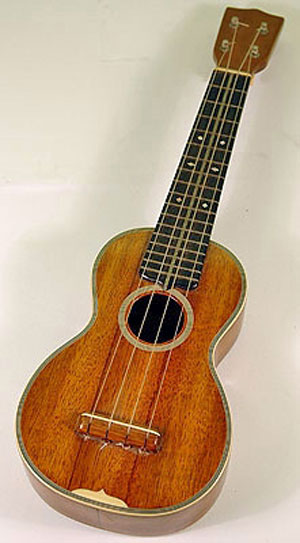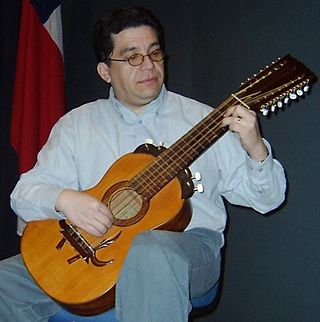Related Research Articles
A mandolin is a stringed musical instrument in the lute family and is generally plucked with a pick. It most commonly has four courses of doubled strings tuned in unison, thus giving a total of eight strings. A variety of string types are used, with steel strings being the most common and usually the least expensive. The courses are typically tuned in an interval of perfect fifths, with the same tuning as a violin. Also, like the violin, it is the soprano member of a family that includes the mandola, octave mandolin, mandocello and mandobass.

The ukulele, also called a uke, is a member of the lute family of instruments of Portuguese origin and popularized in Hawaii. It generally employs four nylon strings.

A twelve-string guitar is a steel-string guitar with 12 strings in six courses, which produces a thicker, more ringing tone than a standard six-string guitar. Typically, the strings of the lower four courses are tuned in octaves, with those of the upper two courses tuned in unison. The gap between the strings within each dual-string course is narrow, and the strings of each course are fretted and plucked as a single unit. The neck is wider, to accommodate the extra strings, and is similar to the width of a classical guitar neck. The sound, particularly on acoustic instruments, is fuller and more harmonically resonant than six-string instruments. The 12-string guitar can be played like a 6-string guitar as players still use the same notes, chords and guitar techniques like a standard 6-string guitar, but advanced techniques might be tough as players need to play or pluck two strings simultaneously.

The seven-string guitar adds one additional string to the more common six-string guitar, commonly used to extend the bass range or also to extend the treble range.
The term requinto is used in both Spanish and Portuguese to mean a smaller, higher-pitched version of another instrument. Thus, there are requinto guitars, drums, and several wind instruments.

A tiple, is a plucked typically 12-string chordophone of the guitar family. A tiple player is called a tiplista. The first mention of the tiple comes from musicologist Pablo Minguet e Irol in 1752. Although many variations of the instrument exist, the tiple is mostly associated with Colombia, and is considered the national instrument. The Puerto Rican version characteristically has fewer strings, as do variants from Cuba, Mallorca, and elsewhere among countries of Hispanic origin.

A setar is a stringed instrument, a type of lute used in Persian traditional music, played solo or accompanying voice. It is a member of the tanbur family of long-necked lutes with a range of more than two and a half octaves. Originally a three stringed instrument, a fourth string was added by Mushtaq Ali Shah by the mid 19th century. It is played with the index finger of the right hand.
In music, standard tuning refers to the typical tuning of a string instrument. This notion is contrary to that of scordatura, i.e. an alternate tuning designated to modify either the timbre or technical capabilities of the desired instrument.
The cuatro is a family of Latin American string instruments played in Colombia, Puerto Rico, Venezuela and other Latin American countries. It is derived from the Spanish guitar. Although some have viola-like shapes, most cuatros resemble a small to mid-sized classical guitar. In Puerto Rico and Venezuela, the cuatro is an ensemble instrument for secular and religious music, and is played at parties and traditional gatherings.

A classical guitar with additional strings is a nylon-string or gut-string classical guitar with more than six strings, in which the additional strings pass over a fingerboard so that they may be "stopped" or fretted with the fingers. These are also known as extended-range guitars, and should not be confused with harp guitars.

The çifteli is a plucked string instrument, with only two strings, played mainly by the Albanians of northern and central Albania, southern Montenegro and parts of North Macedonia and Kosovo.

On a stringed instrument, a break in an otherwise ascending order of string pitches is known as a re-entry. A re-entrant tuning, therefore, is a tuning which does not order all the strings from the lowest pitch to the highest pitch.

Laúd is a plectrum-plucked chordophone from Spain, played also in diaspora countries such as Cuba and the Philippines.

The Guitarrón Chileno is a guitar-shaped plucked string instrument from Chile, with 25, 24 (rarely), or even 26 strings. Its primary contemporary use is as the instrumental accompaniment for the traditional Chilean genre of singing poetry known as Canto a lo Poeta, though a few virtuosi have also begun to develop the instrument's solo possibilities.

The Colombian tiple is a plucked string instrument of the guitar family, common in Colombia where it is considered one of the national instruments. About three-fourths the size of a classical guitar, it has twelve strings set in four triple-strung courses. It is played as a main instrument or as an accompanying instrument to the guitar.

The bandolin is a 15-stringed musical instrument in Ecuador. It is used as a rhythm and melody instrument in the Andean region of Ecuador during festivals where dancing and music are involved. It has a flat back and 15 strings in triple courses.

The rajão is a 5-stringed instrument from Madeira, Portugal. The instrument traces back to the country's regional folk music, where it is used in folklore dances of Portugal in addition to other stringed instruments from the same region.

The Algerian mandole is a steel-string fretted instrument resembling an elongated mandolin, widely used in Algerian music such as Chaabi, Kabyle music and Nuubaat.

The kwitra ; Arabic الكوترة or عود أندلسي ; is an Algerian stringed instrument, sometimes referred to as the Algerian lute. The instrument is tied to Andalusian musical traditions of Moorish people who were pushed out of the Iberian peninsula in the 15th century. That tradition has shrunk further; where the kwitra was once seen in Algeria, today it is mainly an Algerian instrument.

The tambura is a stringed instrument that is played as a folk instrument in Bosnia and Herzegovina, Bulgaria, Croatia, Hungary, North Macedonia, Serbia and Turkey. It has doubled steel strings and is played with a plectrum, in the same manner as a mandolin.
References
- The Stringed Instrument Database Archived 2014-01-14 at the Wayback Machine
- ATLAS of Plucked Instruments